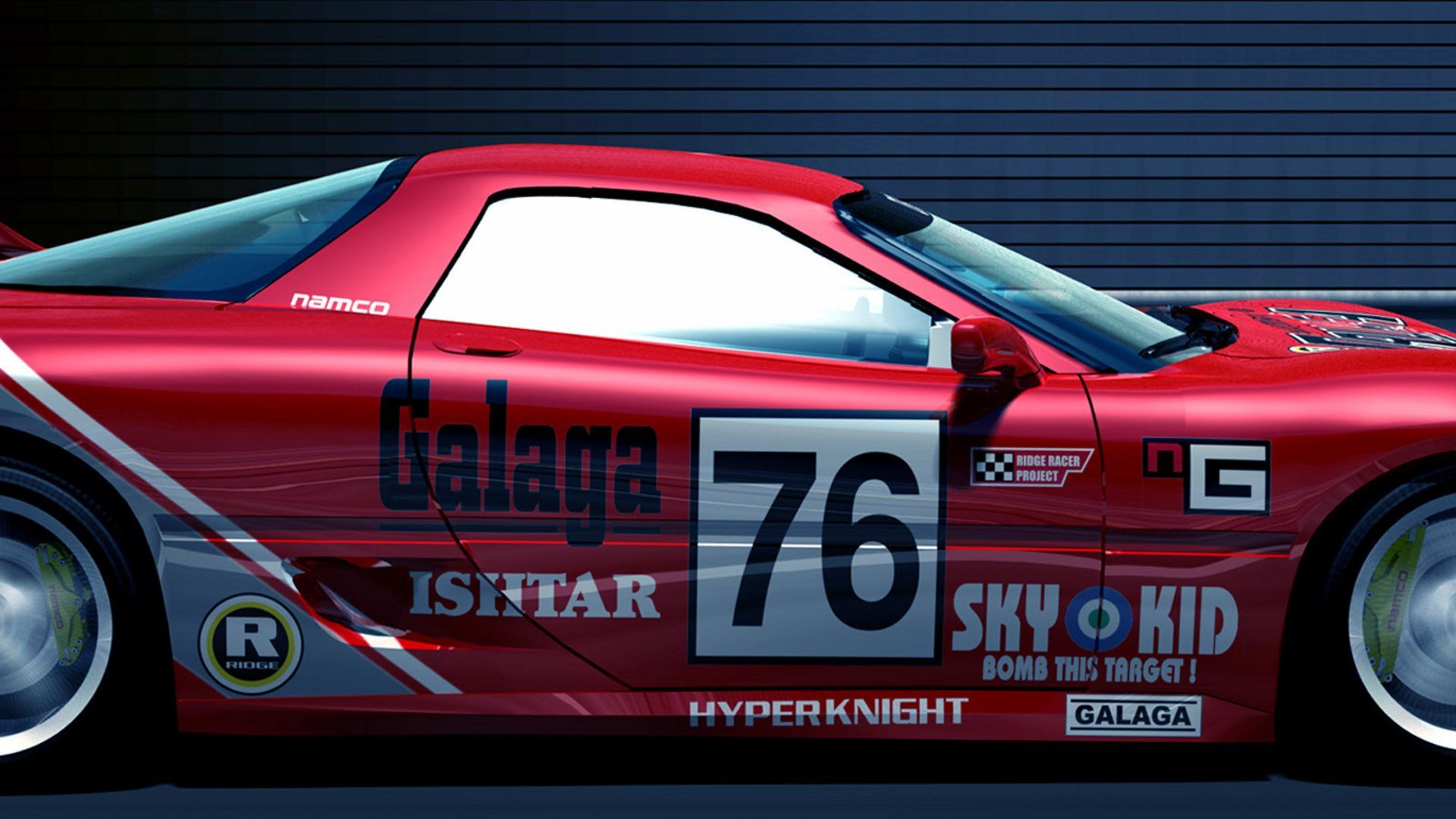Ridge Racer: A Series Retrospective - Crash of the Titan
How a once-great series spun out and lost control

(This article is the second part of a two-part series. I would highly recommend reading part 1 if you are also interested in Ridge Racer’s golden era.)
I think the main thing we wanted to achieve was a game that brought out the same emotions that the original Ridge Racer provoked on the PSone. At the same time we've put a lot of new things into the game which only the PS2 can allow. So, the cars and car mechanics are a lot more detailed, the backgrounds are more realistic and we could manage 60fps in real-time to bring out the ‘emotion’ of the game.’
Eiichi Saita, Ridge Racer V Senior Project Director (Official UK Playstation 2 Magazine - Issue 1)
Eiichi Saita, if only you knew how damaging this philosophy would become.
The millennium marked a crucial turning point for gaming history. After spending the last decade getting to grips with 3D spaces and how to interact with them, the next decade would see huge leaps in game design, solidifying a lot of the trends and maturing into the stable gaming landscape we have today. Plenty of gaming journalists and video essayists have pointed to the transition to 3D as a cutthroat time for long-standing developers and series’, with many failing to effectively translate their gameplay to the land of the Z axis. There’s some merit to that, but I would argue that 2000-2010 was a far more brutal time. Technology finally allowed for almost anything to be attempted, so that’s exactly what many did. Genres and IPs could rise and fall in just a few short years, starting strong as titans of the medium at the beginning of the decade but losing all relevance by the end - just look at 3D platformers like Ratchet and Clank, Jak, and Sly Cooper.
But it wasn’t just the newcomers struggling. IPs that had risen to stardom in the early 3D era now had to prove that they were more than just a gimmick from a time when some fancy triangles were the height of novelty. Some struggled at first but found their footing, like Tomb Raider and Resident Evil, but others completely failed to impress a quickly expanding market.
Namco couldn’t have foreseen this, though, when developing their launch title for the PlayStation 2. After all, the generation didn’t really pick up steam until Sony’s console dropped. So perhaps we can forgive Eiichi Saita for assuming that simply repeating yesterday’s victories would be enough. After all, Ridge Racer V was another solid entry but this time built on more advanced tech, and that is exciting. Clearly, it was exciting enough for the critics of the time, as Ridge Racer V reviewed very well (sitting at a proud but modest 78 on Metacritic).
It’s a very fun game, and I do recommend trying it to any Ridge Racer fan, but this article isn’t really about Ridge Racer V, because that game stands as the last in the series to exude any kind of confidence about its own identity. See, Namco were quick to feel the heat of competition in the years after the PS2 launch title, and following entries would veer back and forth from complete overhaul to dangerously conservative in the coming decade.
Case in point, meet: R: Racing Evolution, the Ridge Racer game that’s actually a Gran Turismo game.

No Drifting Allowed
I’m not going to mince words - R: Racing Evolution wants to be Gran Turismo, and it reeks of desperation. It’s not even an arcade racer, it’s a god-honest circuit-racing simulation. Namco went all in with real tracks and real cars, spurning the iconic cars, racing teams, and tracks built up through the ‘90s. Much like Gran Turismo, winning races earns you credits to allow you to buy new cars or retune your old ones for upcoming races. Like Gran Turismo, this would advance you through more complex races and more difficult competition. Did I mention Gran Turismo? This is Gran Turismo.
None of this is to say that the game isn’t good. It’s a fairly fun, competent racing sim for the time, and it does throw in some classic Ridge Racer charm. The main game is a story mode, with the gloriously cheesy tale of an ambulance driver who is noticed by a racing team after she delivers a patient to the hospital in a record-breaking, tyre-screeching Crazy Taxi-esque rush (no, really). Leaving her EMT days behind her, she joins the racing team and dreams of becoming a top racing driver. It’s wonderfully daft, and the campy cutscenes in between races hearken back to Ridge Racer Type 4’s visual novel sections and serve as a warm reminder that yes, you are playing a Ridge Racer game. Which is good, because you probably spent the last ten minutes staring at tarmac and trying not to drift on the corners.
It even throws in a new mechanic which is an incredibly clever hybrid of the sim racing and the game’s arcade roots. Tailgating an opponent will slowly fill up a “pressure” metre, eventually psyching them out and causing them to swerve out of your way. It feels like a mechanic you would find in a Burnout or Need For Speed game but it’s also… an entirely plausible racing tactic? A scumbag tactic, obviously, but you can easily argue that the pressure metre is simply a symptom of a racing sim’s attention to detail - which is both genius and hilarious.
Critical reception for R: Racing Evolution was intriguingly mixed. It seems to have struck gold for some and hit dirt for others. For me, it was perfectly fine, but I’ll likely never play it again. Namco thought the same, apparently, because they never revisited the idea.

Losing Horsepower
Back in the land of proper ridge racing, innovation had more or less dried up. Ridge Racer 2004 appeared as a PSP launch title, as was now expected, and even got an expanded version released two years later. Some will tell you that the PSP Ridge Racers are the peak (they’re wrong but you can’t blame them). PSP Ridge Racer is, after all, the ultimate greatest hits collection, including every single racetrack from all previous games and (perhaps even more importantly) every single OST track. How can you not love that? And yet, the PSP entries mark the beginning of the end for series for one simple reason:
There was a boost mechanic. Nitrous fuel is rewarded to you for exciting driving. It was taken wholesale from Burnout.
There’s a lot to be said about that.
For one thing, it dilutes the simple racing joy of previous games, tipping the scales a bit more towards arcade and away from sim, when the series always had the perfect balance. More crucially in hindsight, however, is that it reveals insecurity. There is a very obvious attempt to lift a core mechanic from Burnout, the iconic arcade racer which was about to release its magnum opus Burnout 3: Takedown that year. Namco was feeling the heat from competition, and it’s clear they didn’t think just being Ridge Racer was enough anymore. Keep an eye out for this pattern going forward - you’ve seen nothing yet.
The other concerning issue with the PSP entries is the reliance on old tracks and, dare I say it, an appeal to nostalgia. The ‘greatest hits’ angle is a very cool gimmick for that game, and Ridge Racer has never been afraid to reuse content, but this model began to wear patience thin once we get to Ridge Racer 6.
Ridge Racer 6 was the Xbox 360 launch title, and it was basically a nice 7th gen lick of paint on the PSP game with some new tracks piled on top.. Then Ridge Racer 7 arrives a year later to help launch the PlayStation 3 and it’s… basically the game as the Xbox 360 game, with some minor graphical and gameplay improvements. The boost mechanic is still going strong, by the way. By the time we get to 2011’s Ridge Racer for the Vita, series fatigue had seriously set in, with major publications such as GameSpot noticing that many aspects of the game were ported from Ridge Racer 7.
This all sounds very negative, so I feel the need to mention that none of these games were bad in any way. They are all classic Ridge Racer experiences and still very fun to play. The criticisms were levied mostly at Namco for reusing tracks. By this point, even just some fresh assets would have been appreciated. The series had been reduced to a copy-paste exercise.
Namco needed something fresh, and the good news is that they were soon to significantly shape up the formula. The bad news is that the result was the first truly terrible Ridge Racer.

The Crash and Burn(out)
Ridge Racer Unbounded was released in 2012, a year after the Vita release, and swiftly sealed the coffin on the Ridge Racer franchise. Remember that insecurity about Burnout back in 2004? Well, this game is Burnout. Seriously, it’s almost identical.
- Takedown mechanic? ✔
- Hidden secret pathways behind breakable walls? ✔
- Tracks set in busy traffic-filled streets? ✔
- Giant golden arrows to push you harmlessly back onto the track? ✔
- Crash mode? ❌(Wait, what? THEY DIDN’T COPY THE BEST PART??)
Created by the Finnish team Bugbear Entertainment instead of the usual Japanese studios, Ridge Racer Unbounded is an embarrassingly shameless attempt to ape the Western arcade racing franchise. Which is especially odd considering that Burnout’s final entry had already come and gone four years earlier when Burnout Paradise released in 2008. It’s a dying game series attempting to revive itself by copying a similar franchise which had already died. It would be funny if it wasn’t so tragic, because Unbounded bombed hard, rightfully so, and Ridge Racer hasn’t seen another major entry since. Only a few cheaply made mobile games have appeared since 2012, and even the latest of those is no longer available to download.
And so there ends the legacy of a once genre-defining racing game. As they say, not with a crash mode, but with a whimper. Up until the final game, it’s hard to pinpoint exactly what Namco did that was so wrong - the games were still great after all. Perhaps it was simply that arcade racing wasn’t the show stopping genre it had once been in the mid nineties. Ah well, fashion is cyclical and genres always come back eventually.
And when it does, I hold out hope that I’ll be drifting around those mountaintops all over again.
If you enjoyed this article, consider following me on Twitter @teffers for more nostalgic ramblings from a man too young to really care this much about the past.
